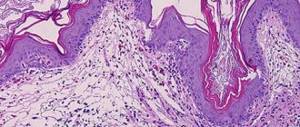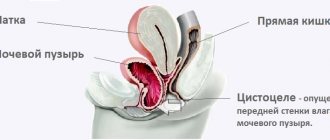The bladder belongs to the genitourinary organ system; it stores urine, which is then excreted through the urethra. However, when unfavorable conditions are created for the body, disturbances in the normal function of the bladder may occur.
One of the diseases, according to medical indicators, identified as a separate independent nosological form, is bladder ulcer. The cause of the disease can be inflammatory processes, as a result of which the integrity of the mucous membrane of the organ is disrupted. This disease is also called interstitial cystitis, which is characteristic mainly of the fair half of humanity. However, men are not immune from it either.
Almost always, pathological phenomena appear on the back wall of the bladder, closer to the upper part of the ureter. The ulcer may be round or oval in shape with clearly defined edges, red in color with a purulent coating. At the same time, it constantly bleeds, which leads to pain.
The ulcerative area can have various shapes, among them the main ones are: oval, stellate and linear, and its size can reach several centimeters.
Bladder ulcers are divided into several types: simple, which occurs due to circulatory problems when the vessels of the organ are compressed. Tuberculosis, caused when diagnosing tuberculosis of the bladder; it is characterized by fairly deep wounds. A post-traditional ulcer usually appears after chemotherapy or radiation in a patient with cancer.
This disease is more like a manifestation of chronic cystitis, and therefore may be accompanied by pain in the lower abdomen, especially when the bladder is full.
An increase in the urge to go to the toilet, including false ones, sometimes they can reach a record level per day, more than 30 times. The patient may also experience discomfort and pain during intimacy.
Not always, but other manifestations of pathology are possible:
- Temperature increase.
- Bloody inclusions in urine.
- Pain syndrome in the pelvic region, perineum and lower back.
- Exacerbations of the disease may occur when eating spicy and salty foods.
The manifestation of the disease can occur cyclically, starting with sudden pain during an exacerbation and gradually decreasing. As a rule, symptoms can occur according to different indicators, and will depend on the stage of development of the pathology. In women, exacerbations sometimes occur before the onset of menstruation.
Diagnostics
Any disease requires proper treatment, including bladder ulcers. Therefore, if at least one of the symptoms described above appears, you should consult a doctor and undergo a full examination.
During a visual examination, doctors examine the patient's internal genital organs, rectum and anus, and also test the sensitivity of the bladder. Next, laboratory and instrumental examinations are prescribed.
The patient must:
- Donate blood and urine for biological testing for the presence of leukocytes, erythrocytes, bacteria, which may indicate the development of pathology.
- A study is also carried out to determine the presence or absence of sexually transmitted diseases.
- Instrumental studies include cystoscopy, which can give the most complete picture of the development of the disease: the location of the ulcer, its size.
- A biopsy of the affected organ determines the presence or absence of benign and malignant tumors.
- Additionally, an ultrasound examination is performed.
Once the diagnostic results are ready, the doctor can see the full picture of the disease and, accordingly, prescribe comprehensive treatment depending on the stage of development of the pathological process.
Treatment
According to statistics, a bladder ulcer is a rather complex disease that requires long-term treatment. For this purpose, conservative therapy can be used, which is most effective at the initial stage of the disease.
To do this, rinse the bladder with synthomycin liniment in the form of droppers, as well as solutions with silver ions and fish oil. The use of antibacterial, antispasmodic, analgesic and diuretic agents. Immunomodulatory drugs and vitamin complexes are required.
In more severe cases, if traditional therapy does not bring the desired positive results, the only option for the patient is surgery. This is done in several ways:
- Resection, as a result of which the damaged area of the bladder and adjacent healthy tissue are removed.
- Plastic surgery is possible with the replacement of mucous areas to enlarge the organ, which will create normal functioning of the bladder.
- Laser cauterization of an ulcer is considered the most effective and less painful method, as a result of which only minor scars remain on the walls of the organ.
Despite all the manipulations performed, there is always the possibility of relapse of the disease, so the patient is strictly recommended to constantly undergo follow-up examinations and maintain preventive measures.
Bladder ulcers occur unexpectedly and are accompanied by symptoms such as pain when urinating and hematuria. And using mumiyo for bladder ulcers
, you can significantly improve your health and avoid the need for severe and lengthy antibiotic treatment. However, it is important to know how to do it correctly, and we will pay special attention to this issue.
Simple treatment plan
Every day, in the morning, take 0.2 g of Altai mumiyo in an aqueous solution. You need to drink this solution two hours before breakfast for ten days, and then, after waiting another ten days, you can repeat the course.
With the help of natural mumiyo you can achieve amazing results - and it’s not surprising, because treatment of bladder ulcers with the help of mumiyo
is based on the restorative, wound-healing and general strengthening properties of the resin. However, remember that tableted mummy is not very effective.
Methods of using mumiyo for bladder ulcers
To treat a patient with a bladder ulcer, it must be carried out according to a specific scheme and with strict adherence to dosage. In this case, you can use one of the following recipes.
Complex treatment regimen
Even if you use the folk remedy in question in accordance with a simple treatment regimen, it will be beneficial in any case. However, the maximum effect can be achieved using the recipe below.
Three times a day, consume 0.2 g of natural mumiyo, dissolved in 100 ml of warm milk, and before going to bed, douche with an aqueous solution of this substance (it can be prepared by mixing 1 g of Altai mumiyo with 100 ml of boiled water). The course of treatment will be nine days.
Another option
You can conduct a ten-day course of douching with a 1% aqueous solution of natural mumiyo. And at the same time you should take this solution orally according to the following scheme:
- during the first seven days - 30 drops three times a day;
- over the next seven days – a teaspoon three times a day;
- another seven days - three times a day, one and a half teaspoons.
Use these proven regimens to combat the disease, and you will get excellent results without any risk to your health.
A simple bladder ulcer (interstitial cystitis) is a rare disease, the etiological factor of which is a violation of the blood circulation of the bladder area due to embolism of a large vessel, septic thrombosis, compression of blood vessels by an inflammatory infiltrate.
Symptoms and clinical course of bladder ulcers
The disease occurs as chronic cystitis, manifested by pain in the bladder area, frequent and painful urination, and periodic admixture of blood in the urine. The course of the disease is usually long-term, with periodic exacerbations, during which urination becomes more frequent (up to several dozen times a day) and painful. In women, exacerbation of the disease often occurs in the premenstrual period.
Diagnosis of bladder ulcer
The diagnosis of a simple bladder ulcer is based on a history of long-term urination disorders (frequency and pain), periodic terminal hematuria, but mainly on objective data, i.e., detection of a bladder ulcer during cystoscopy. It is usually located in the apical region, often single, round in shape, with sharply defined edges. The bottom of the ulcer is light red in color, sometimes covered with fibrinous-purulent plaque, around the ulcer there is swelling and inflammation of the mucous membrane. When you touch the ulcer with an instrument, it bleeds easily. During an exacerbation of the disease, the urine contains an increased number of leukocytes and red blood cells; without an exacerbation, changes in the urine may be insignificant or absent.
Differential diagnosis of bladder ulcer
A simple bladder ulcer must be differentiated from ulcerative changes of another origin (tuberculous, tumor, post-radiation). The leading method of differential diagnosis in these cases is endovesical biopsy.
Treatment of bladder ulcers
Conservative treatment methods include antibacterial drugs, instillation into the bladder of solutions of silver nitrate, fish oil, syntomycin liniment, etc. If there is no effect from conservative therapy, they resort to transurethral electroresection or resection of the bladder, intestinal plastic surgery (creation of an additional reservoir from a segment intestines).
Bladder ulcer prognosis
The outcome of the disease is most often unfavorable: despite persistent conservative therapy, interstitial cystitis progresses, ultimately leading to shrinkage of the bladder. After surgical treatment (resection of the bladder), the prognosis is better, however, it does not guarantee against relapse and further progression of the disease.
A chronic disease during which an ulcer appears on the inner wall of the bladder. In most cases, a bladder ulcer is located in the upper part of the bladder and has an oval or round shape, covered with purulent plaque on top, and is accompanied by light bleeding. The ulcer is surrounded by a zone of inflammatory changes.
Causes of renal papillary necrosis
Conditions contributing to the development of renal papillary necrosis:
• chronic and acute pyelonephritis; • obstruction of the urinary tract; • sickle cell hemoglobinopathy; • urogenital tuberculosis; • liver cirrhosis, chronic alcoholism; • irrational use of painkillers; • kidney transplant rejection; • radiation therapy; • diabetes; • systemic vasculitis.
More than 50% of patients with renal papillary necrosis have two or more of the listed causative factors, i.e., the pathological process in most people has a multifactorial origin. Nephrologists identify several main causes of papillary destruction:
• Impaired blood supply to the medulla.
Systemic vasculitis, vascular changes due to diabetes mellitus, cholesterol deposits due to atherosclerosis cause a decrease in blood flow with a deficiency of nutrients and oxygen in the papillary apparatus. Thrombosis of the renal vessels with ischemic phenomena can be caused by sickle cell anemia, disseminated intravascular coagulation syndrome and other conditions associated with hypercoagulation.
• Increased intrapelvic pressure. Urodynamic disorders initiate stagnation of urine in the collecting system, which contributes to the development of pyelorenal reflux. Urine is a breeding ground for pathogenic and opportunistic microorganisms, so in the future the situation is aggravated by the addition of an acute inflammatory process. Impaired ureter outflow and pelvic hypertension can be caused by a tumor, calculus, iatrogenic ligation of the ureter during surgery, etc.
• Purulent destructive process in the kidneys.
Sometimes inflammation of the apices of the renal pyramids is secondary and is considered as a complication of severe purulent-destructive processes: apostematous pyelonephritis, renal abscess, carbuncle, purulent inflammation. Microbes in the process of life produce proteolytic exotoxins that melt the parenchyma of the organ. The process involves the papillae, pyramids, and other structures of the kidney.
• Drug-induced nephropathy.
One of the most common but preventable etiological factors is the use of analgesics, in particular phenacetin and its highly toxic metabolite p-phenetidine. Therefore, the recent growing popularity of nonsteroidal anti-inflammatory drugs (NSAIDs), especially those that inhibit cyclooxygenases (COX-1, COX-2), has led to a relatively high incidence of adverse events in patients at risk of developing renal papillary necrosis.
Treatment of bladder ulcers
How is a bladder ulcer treated?
What is the treatment for ulcers at the initial stage?
At the initial stage of treatment, standard methods are used, which include antibacterial drugs. The bladder is washed with a solution of silver nitrate, accompanied by the introduction of sea buckthorn oil or dibunol into the bladder.
When is surgery indicated for a bladder ulcer?
It often happens that standard conservative methods of treating bladder ulcers do not bring results, then mechanical removal of the ulcer through the urinary canal or direct surgery is performed. If the bladder ulcer is large enough, then bladder plastic surgery is performed using a section of the intestine. But even all the operations performed to treat a bladder ulcer may not complete the process of cystitis, and inflammatory processes may continue in the body again.
Is it possible to prevent recurrence of bladder ulcers?
Yes, thanks to modern medicine and high-quality operations, as well as a properly selected postoperative period, ulcer recurrence can be avoided.
Symptoms of a bladder ulcer
What are the main symptoms of a bladder ulcer?
A bladder ulcer does not have pronounced symptoms; they are very similar to the symptoms and signs characteristic of ordinary cystitis. These include periodic pain in the bladder area that increases as the disease progresses, and frequent urination.
Laboratory tests diagnose a bladder ulcer based on test results. But, by far, the most accurate diagnosis is cystoscopy, during which you can see and determine the location of the ulcer.
Prevention
Bladder ulcers are rare, but if provoking factors have already occurred, the disease is difficult to avoid. Prevention methods such as regular visits to doctors and proper treatment of diseases that contribute to the development of interstitial cystitis will help you avoid resorting to radical treatment methods.
Thus, only timely treatment can lead to pain relief and a positive recovery outcome. The advanced form of the disease is difficult to treat and even after surgery, relapses often occur.
Causes of bladder ulcers
The causes of bladder ulcer disease are not known, and none of the existing theories has been confirmed. The infectious fact was also not confirmed.
Possible causes of bladder ulcers may include:
- an increase in the number of mast cells in the bladder mucosa; the cause-and-effect relationship is not obvious;
- failure of the inner layer of the surface of the bladder allowing destructive elements to pass to the walls of the bladder;
- infection with a nutrient-demanding bacterium;
- products of toxic substances in urine;
- autoimmune disorders and many others. But none of them have been confirmed.
Anatoly Shishigin
Reading time: 4 minutes
A A
A bladder ulcer occurs as a result of disease and damage to the mucous membrane of this organ, and the symptoms resemble cystitis. Another name for a bladder ulcer is interstitial ulcerative cystitis, which occurs due to damaged blood flow in the organ. Blood circulation is disrupted during large-vascular embolism and septic thrombosis, when the vessels are compressed by infiltrate with inflammation.
Causes
The main cause of the disease is a violation of the integrity of the lining of the urinary organ due to chemical burns and ongoing bacterial processes.
The exact causes of this disease have not been established by medicine, but the following factors may contribute to this:
- Damage to the organ by parasites, E. coli.
- Poor blood circulation in certain areas of the organ.
- Tumor.
- Chronic cystitis.
- Growth of mast cells causing inflammation.
- Hypoxia of the bladder.
- The appearance of toxic substances in the urine.
- The growth of epithelial cells and the regeneration of damaged cells stops,
- Tuberculosis or syphilis,
- Chemotherapy for all forms of oncology.
Description of the disease
Bladder ulcer is a disease with an independent nosological form. Most often, this pathology occurs in women, but men are also susceptible to a similar disease. Bladder ulcers can be caused by inflammatory processes in the genitourinary system. When the integrity of the mucous organs is damaged due to chemical, thermal or radiation burns, ulcerative formation also occurs.
Pathology can be provoked by any disorder that is associated with the nutrition of the walls with blood, the supply of insufficient tissue with nerves connecting the organ with the central nervous system. The breakdown of the tumor that occurs inside the bladder can also cause disturbances in the surface of the mucous membranes, which causes an ulcer. And in some cases, single ulcer formations may appear, the most common location of which is the posterior wall of the bladder near the apex.
Stones and sand
Stones and sand in the organ cavity are formed under the influence of various factors, but only when there is a disturbance in the structure and functioning of the urinary system, their deposition occurs. Symptoms of stone formation depend on the location and size of the solid particles.
Stones and sand in the organ cavity are formed under the influence of various factors.
They appear as:
- pain of varying intensity, especially during the release of stones or sand;
- the mechanical effect of sand on the mucous membrane causes inflammation;
- changes in the transparency and color of urine, for example, cloudy, mixed with blood;
- altered urination pattern: the patient feels frequent urges, but the volume of urine released is insignificant.
Atypical symptoms of bladder stones include:
- nausea and vomiting;
- hyperthermia;
- increase in pressure.
Large stones cause severe pain, which subsides only if the patient takes a lying position.
Types of ulcers
The ulcer can be of different shapes, most often oval, star-shaped or linear. The size of the lesion in the ulcerated area is about 4 cm. The contours of the spot are clearly visible and have slight swelling. In the center there is an area with a bright blood-colored ulcer, and the wound is constantly bleeding. The mucous membranes that are not affected by the lesion are unchanged. Hormonal imbalance or neurogenic factors do not affect the formation of ulcers.
Simple or interstitial cystitis
This ulcerative formation occurs due to impaired blood flow in the local area of the bladder. Blood circulation stops due to a blocked vessel. Symptoms manifest themselves in the form of acute pain, discomfort during deurination, and bloody discharge in the urine. Such symptoms are also characteristic of cystitis.
The formation is single in nature and is located at a distance from the connection of the bladder with the ureter. At the same time, all surfaces of the organ wall are involved in the process of ulcerative lesions, which distinguishes this disease from the tuberculosis type. In the center of the lesion, necrosis and bleeding can be noted. Such an ulcer can be confirmed using cystoscopy.
Post-radiation form
The type of ulcer of a post-traditional nature occurs after treatment with radiation exposure to malignant formations in the organ. Radiation causes dilation of the walls of blood vessels in the bladder, which disrupts the processes of cell regeneration and their metabolism. Intensive radiation therapy creates ulcerative wounds. Such an ulcer can be eliminated both with medications and surgery.
Tuberculosis
The form of ulcer of the tuberculous variety refers to pathologies outside the pulmonary system caused by Koch's bacillus. With the blood flow, as well as through the lymph, it spreads throughout the body, in particular, through the genitourinary system. The kidneys are immediately affected, so the infection immediately enters the bladder and causes inflammation of the triangle there.
There is also a narrowing of the urethra, through which urine is removed from the body. Pathogens are resistant to acids, multiply quickly in the organ and affect the walls of the bladder at great depths in their layers. If you do not apply timely medication therapy, you can get complications in the form of the following symptoms:
- scarring at the site of the ulcer;
- narrowing of the organ;
- transformation of muscles into fibrous tissue;
- perforation in the walls of the bladder.
Recommended Diet
When starting treatment for radiation cystitis, it is important to adhere to a special diet, excluding foods that can cause irritation of the bladder mucosa. Based on this, it will be useful to avoid eating onions, horseradish, garlic, hot peppers and radishes.
The diet must include:
- fish fat;
- berries and sea buckthorn oil;
- natural juices;
- milk;
- vegetables, fish, veal and rabbit meat.
To quickly cleanse yourself of pathogenic bacteria and reduce the spread of cancer, you need to eat watermelons and melons every day. Such nutrition should not be thought out on your own; everything should be coordinated with a nutritionist, who will determine which foods are especially useful and not recommended for consumption in case of radiation damage to the bladder mucosa. In the worst case, it can cause irreversible reactions.
This is also given great importance. In an unambiguous order, all irritants of the urinary mucosa are excluded from the usual food: garlic, radish, onion, sorrel, horseradish, broths with meat, fish and mushrooms, smoked, salty foods, everything fried, sauces.
It is necessary to consume more cereals and fresh vegetables. Fish oil and sea buckthorn oil are beneficial. You should drink more liquid: tea with milk, mineral or plain water, birch sap.
Remember that such diets must be prepared by a nutritionist with a medical education. It is very important when a patient, during a course of chemical therapy, consumes foods that help restore the mucous membrane.
Symptoms and diagnosis
The symptoms of a bladder ulcer are very similar to the symptoms of cystitis in the chronic stage. Peptic ulcer disease is always accompanied by severe pain in the lower abdomen. The painful sensation increases as the bladder fills with fluid, and also becomes acute at the end of deurination. The purity of urges increases significantly, in some cases reaching 40 times a day.
A visual examination of urine can reveal signs of gross hematuria and pyuria, which indicates the presence of an ulcer in the bladder. Often patients note other symptoms that are associated with terminal and total hematuria. With the total type of hematuria, all urine is colored the color of blood, and with terminal hematuria, only the last stream during urination is colored.
The ulcer has a cyclical course of the disease, it can subside and be asymptomatic, but in the future new, stronger sensations will appear, characteristic of the period of exacerbation. In women, exacerbations most often occur during the premenstrual period. In general, exacerbations begin with the abuse of salty or spicy foods, also in damp, cold weather.
As soon as symptoms appear, the patient should contact the attending physician and request a diagnosis. Specialists perform cystoscopy to detect ulcers in the bladder. The insertion of an endoscope with a built-in eyepiece and lighting system into the urethra is quite painful for the patient, since the functional volume in the bladder is significantly reduced.
The doctor further examines the patient's rectum and anus. To exclude infection of the urethra, a urine test is performed for bacteriological culture, as well as a general analysis. A bladder sensitivity test may be necessary, in which a solution of potassium and water is injected into the cavity. The patient should tell the doctor at what stage the pain begins. If there is a suspicion of tumor growth, the doctor writes out a referral for a biopsy.
Consequences and complications
Untimely contact with specialists or an advanced ulcer can lead to such consequences and complications as:
- Intoxication of the body.
- Shrinking of the bladder, loss of elasticity and ability to contract.
- Urinary incontinence.
- The appearance of scars on the walls of the urinary organ.
- Painful sensations as the bladder fills.
- Chronic sphincter dysfunction.
- Partial death of mucous membrane tissue in places where ulcerative wounds form.
Treatment
As soon as the doctor has distinguished the presence of a simple ulcer from one of tuberculosis, post-radiation or tumor origin, he means a drug regimen to combat the disease. As a rule, treatment consists of conservative therapy and, in some cases, surgery.
Drug treatment
The main role in treatment is played by antibacterial therapy, which is prescribed in the drug regimen for treating the disease. Moreover, local methods of combating ulcers are used, in particular droppers into the bladder. Through them, the patient is given medications based on silver nitrate, synthomycin liniment and dibunol.
Practice shows the effectiveness of sea buckthorn oil, which helps restore damaged surfaces and heal wounds. Treatment with drugs is most often used for radiation-induced ulcers and has a very long treatment period.
The first step is to wash the walls of the bladder and then irrigate them with medications. Fish oil enriched with vitamins is often used for this purpose. Cortisone and syntomycin emulsion, as well as Shostakovsky balm, have also worked well.
Surgical intervention
If drug treatment does not give the desired result, in order not to complicate the course of the disease and not to worsen the patient’s condition, electroresection is performed. In case of damage to the mucous membrane by ulcerative formations, complete resection of the bladder and subsequent intestinal plastic surgery are performed.
In this case, surgeons create an artificial reservoir from the intestine, which performs the function of a bladder. All surgical interventions are performed in three types - laser, resection and plastic surgery.
An ulcer of the radiation variety manifests itself many months, almost a year, after radiation therapy. They are characterized by continuous swelling of the surface of the bladder, as well as necrosis of the mucous organs. Due to such total damage to the inside of the organs, its functional activity and nutrition of the walls are disrupted.
The situation is complicated by the deposition of salts, which are concentrated in the center of the ulcerated area. Treatment consists of mandatory healing of the wounds that appear.
This method involves the use of electrodes that stimulate the skin. When they are connected, impulses are transmitted that affect blood flow to the bladder. This significantly reduces the urge to deurinate. The method of neuromodulation is also applicable, when electrical pulse signals are transmitted through the nerve plexuses in the organ and spine. It may also reduce the urge to urinate.
Neurostimulation of the urinary










